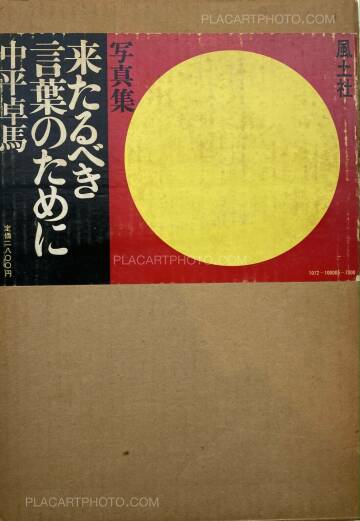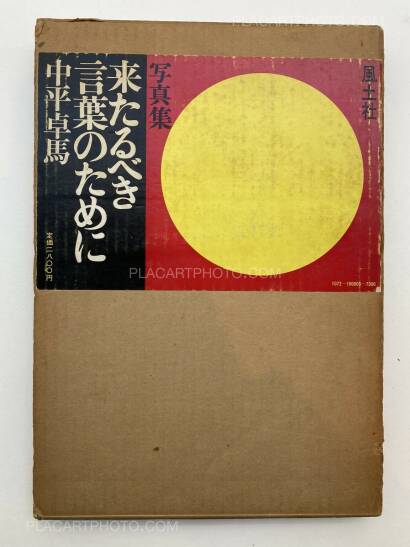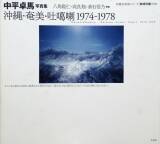For a language to come

Takuma Nakahira
For a language to come
Photographs: Takuma Nakahira
Text: Takuma Nakahira
Publisher: Fudo-sha
192 pages
Pictures: 103
Year: 1970
Comments: Hardcover with jacket and card slipcase, 300 x 212 mm. First edition, 1970. Gravure printing. Included in Martin Parr & Gerry Badger, The Photobook, vol. I, p.292-293 ; Ryuichi Kaneko & Ivan Vartanian, The Japanese Photobooks of the 1960's and 1970's, p.130-133. Very good condition other than a small tear to the spin of the dust jacket. Very scarce.
"Through his photographs and writings Takuma Nakahira was both the chief polemicist for the Provoke group and its political conscience. Along with Moriyama's Sashin yo Sayonara (Bye Bye Photography), his book Kitarubeki Kotoba no Tameni (For a language to come) marks the apogee of the Provoke period. It exhibits all the characteristics of the Provoke style - an unabashed revelling in "bad" photographic technique, the mannerisms of the New York School pushed to the edge of coherence. These qualities would tend to make the casual reader bracket it with Moriyama's masterpiece, yet a closer look at Nakahira's book reveals that Nakahira's sensibility is quite different. Althoug the more political of the two, Nakahira didt not photograph "political" subjects directly, but utilized a troubled lyricism to express his disaffection with the colonization of Japan by American consumerism. Whereas Moriyama is jumpy and frenetic in tone, Nakahira displays a brooding calm. For a language to come closes with several shots of the sea, and the book's narrative is punctured at intervals with marine images. Far from suggesting boundless space, this is a dark, bleak and menacing sea, with the consistency of soup, a metaphor for claustrophobia and a narrowing of horizons.
The other overwhelming metaphor in the book is fire, an apocalyptic, post-Hiroshima conflagration, often expressed indirectly in Nakahira's night pictures with swathes of burned-out lens flare. These "natural" metaphors - water and fire - remind us that this is essentially a "landscape" book, though a landscape of the mind. The two, however, are inextricably related (...). These are sad, beautiful pictures of half-light - and half-life. They are quintessential Provoke images, and stand for much postwar Japanese photography prior to the 1980s."
Martin Parr & Gerry Badger, The Photobook: A History, vol.I















more books by Takuma Nakahira
-
Okinawa, Amami, Tokara 1974-1978
by Takuma Nakahira
sold -
Overflow
by Takuma Nakahira
sold -
Degree Zero - Yokohama
by Takuma Nakahira
sold -
OKINAWA (LTD EDT)
by Takuma Nakahira
Euro 90 -
Aratanaru gyoushi / New Gaze
by Takuma Nakahira
sold
more books tagged »Takuma Nakahira« | >> see all
-
The Japanese Box
by Collective
sold -
Provoke : Between Protest and Performance : Photography in Jap...
by Provoke group
sold -
PROVOKE MAGAZINES (BACK IN STOCK)
by Collective
Euro 100 -
Provoke 4 & 5: First Abandon the World of Pseudo-Certainty
by Provoke group
sold -
Provoke (First edition)
by Provoke group
price on request -
Provoke 2 (First edition)
by Provoke group
price on request
more books tagged »seventies« | >> see all
-
Ipy Girl Ipy
by Tad Wakamatsu
sold -
Night and Day
by David Armstrong
sold -
Ryumin Genshiko
by Katsuya Sakamoto
sold -
A DIALOGUE WITH SOLITUDE (SIGNED)
by Dave Heath
sold -
Colazione sull'erba
by Luigi Ghirri
sold -
Futatsu no biza / China America (DEDICATED)
by Satoshi Arai
sold
more books tagged »provoke« | >> see all
-
Japan: a Photo Theater, Revised Edition (SIGNED)
by Daido Moriyama
sold -
Farewell Photography
by Daido Moriyama
sold -
Provoke : Between Protest and Performance : Photography in Jap...
by Provoke group
sold -
Provoke (Set of 3 vol. +1) 1968-1969
by Provoke group
price on request -
Photography 1965-74 (SPECIAL EDITION WITH PRINT)
by Yutaka Takanashi
sold -
Farewell Photography
by Daido Moriyama
sold
more books tagged »japanese« | >> see all
-
Inversion / New York edition (Signed)
by Daisuke Yokota
sold -
FOR THE SAKE OF FUTURE DAYS
by Katsuhiro Saiki
Euro 15 -
TELOMERIC (SIGNED)
by Naoki Ohji
Euro 50 -
LOVE IKON (SPECIAL EDT WITH PRINT)
by Kiyoshi Ikejiri
Euro 400 -
28 Girls by Kishin Shinoyama
by Kishin Shinoyama
sold -
Ravens (Karasu) (STILL IN SHRINK WRAP)
by Masahisa Fukase
sold
more books tagged »japanese photobook« | >> see all
-
Ryusei hanabi
by Collective
sold -
Adam and Eve (Signed)
by Nobuyuki Wakabayashi
Euro 1200 -
Eigijin vol.1
by Collective
price on request -
Futto jidaino shozo : Portraits of the 60s (WITH OBI)
by Kenji Ishiguro
sold -
E-HON (picture book) SIGNED
by Shuntaro Tanikawa
sold -
Shimotsui no kodomotachi / Children of Shimotsui (with obi)
by Nobuyuki Wakabayashi
sold
Books from the Virtual Bookshelf josefchladek.com






































;jpg)



 Facebook
Facebook Instagram
Instagram